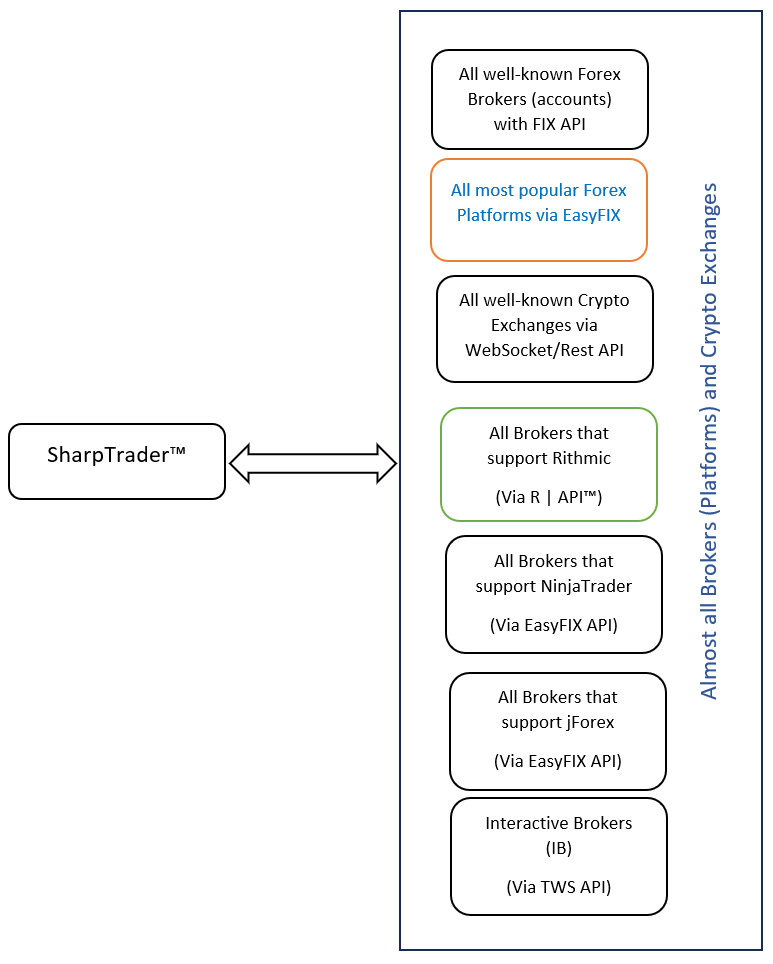-
0
Loading cart contents...
SharpTrader contains built-in connectors for almost all well-known Brokers/Platforms/Crypto-Exchanges via different protocols.

Usually, all common trading terminals and web platforms allow you to connect only to a single broker server. In SharpТrader, we introduce the concept of connection via a universal light version of FIX protocol (called EASYFIX) to bridges that work with different exchanges/brokers. Keeping connectors to exchange(broker) in separate bridge infrastructure is a prudent strategy that offers several advantages. A bridge, in this context, refers to the software responsible for connecting to cryptocurrency, financial exchanges, or broker servers. Here’s an explanation of why it’s better to maintain separate bridge(s) for different exchanges/brokers in different executables and not inside the main program that executes arbitrage and other trading strategies.
By using separate bridges for different exchanges, you isolate the risk associated with each exchange. Each exchange can have its own set of operational issues, vulnerabilities, and potential downtime. If all your connectors are consolidated into a single software, a problem with one exchange could impact your entire trading operation. By separating them, you limit the potential damage.
Maintaining separate bridges allows you to implement redundancy and failover strategies more effectively. If one bridge experiences technical difficulties or goes down, your trading operations can continue uninterrupted through the bridges connected to other exchanges. This redundancy enhances the reliability of your trading infrastructure.
Different exchanges may have unique APIs, order types, trading rules, and rate limits. Using separate bridges enables you to tailor each bridge to the specific requirements of the exchange it connects to. This customization allows for efficient handling of exchange-specific nuances and optimizations, which can improve your overall trading performance.
As your trading strategy grows or you decide to add more exchange/broker to your portfolio, it’s easier to scale when you have separate bridges. You can deploy additional bridges for new exchanges without affecting the existing ones. This modular approach simplifies adapting to changing market conditions and trading needs. Without any changes to the SharpTrader program and strategies, you can develop your own bridge and communicate with SharpTrader via EASYFIX protocol. Another important advantage is that you can keep Bridge and SharpTrader on different servers, which can help camouflage your arbitrage strategies.
Security is a paramount concern when dealing with financial markets and cryptocurrencies. By keeping bridges separate, you can enforce more robust security measures tailored to the specific needs of each exchange. This isolation reduces the risk of a security breach spreading across all your trading operations. Additionally, it may help you comply with exchange-specific regulatory requirements.
Each exchange/broker may have different trading volumes, API response times, and latency characteristics. Separating bridges allows you to optimize the architecture and resources for each exchange individually. You can allocate more resources to high-volume exchanges/brokers, ensuring faster execution and lower latency for those markets.
When you establish a local TCP socket connection to a bridge on the same PC, you can expect minimal to no significant latency compared to other forms of communication (usually, it is less than one millisecond). TCP/IP is a robust and efficient protocol for local communication. When used locally, it’s designed for reliable data transfer and can handle high throughput with very little latency. Since the connection is local, the data doesn’t need to traverse a network. It stays within the same machine. This means no network-related delays or congestion issues can introduce latency. Most modern computers have high-speed buses and interconnects that facilitate low-latency communication between processes on the same machine. This hardware-level optimization further reduces latency.
If issues arise with a particular exchange’s connectivity or API, it’s easier to troubleshoot and diagnose the problem when the bridge is isolated. This isolation simplifies the debugging process, making identifying and resolving issues faster.
In conclusion, maintaining separate bridges for different exchanges/brokers is a prudent approach that provides risk mitigation, operational flexibility, scalability, and customization advantages. It enhances your trading infrastructure’s reliability, security, and performance while allowing you to adapt to the unique requirements of each exchange/broker you engage with. This modular approach is a common best practice in the world of algorithmic trading and financial technology.